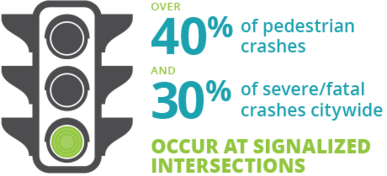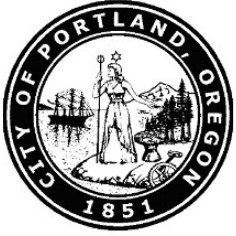News Blog: A new directive for Portland's crosswalks
Portland Bureau of Transportation sent this bulletin at 10/15/2019 03:07 PM PDT
What are high-visibility crosswalks and how are they different? High-visibility crosswalks (sometimes called “continental-style” crosswalks) have thick lines parallel to traffic flow that allow drivers to see the crosswalk from further away. This gives drivers more time to stop safely for pedestrians crossing, or waiting to cross. As new crosswalks are installed or reinstalled by PBOT crews and contractors, they will include these new high-visibility markings. Where an existing crosswalk already exists, such as the type with two white lines perpendicular to traffic, you will see PBOT adding high-visibility markings into the existing striping. 
An example of an older style crosswalk that has been restriped with a high-visibility crosswalk at SE 30th Avenue and Hawthorne Boulevard. New left turn calming rubber speed bumps were also added as part of PBOT's Vision Zero left turn calming pilot. Photo by PBOT. Why the focus on crossings?
Adding high-visibility crosswalks at intersections with traffic signals may help make pedestrians more visible to people driving. PBOT will install these high-visibility crosswalks at intersections with traffic signals and all other marked crossings moving forward. This data-driven approach to solving traffic safety issues is a core tenet of Vision Zero. You can find more information about PedPDX online at www.pedpdx.com. Learn more about Vision Zero online at www.visionzeroportland.com.  The Portland Bureau of Transportation (PBOT) is the steward of the city’s transportation system, and a community partner in shaping a livable city. We plan, build, manage, and maintain an effective and safe transportation system that provides access and mobility. www.portlandoregon.gov/transportation
|
The City of Portland complies with all non‐discrimination, Civil Rights laws including Civil Rights Title VI and ADA Title II. To help ensure equal access to City programs, services and activities, the City of Portland will reasonably modify policies/procedures and provide auxiliary aids/services to persons with disabilities. Call 503-823-5185, TTY 503-823-6868 or Oregon Relay Service: 711 with such requests, or visit http://bit.ly/13EWaCg |









